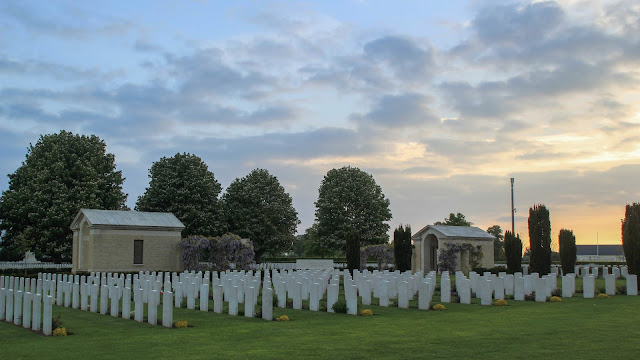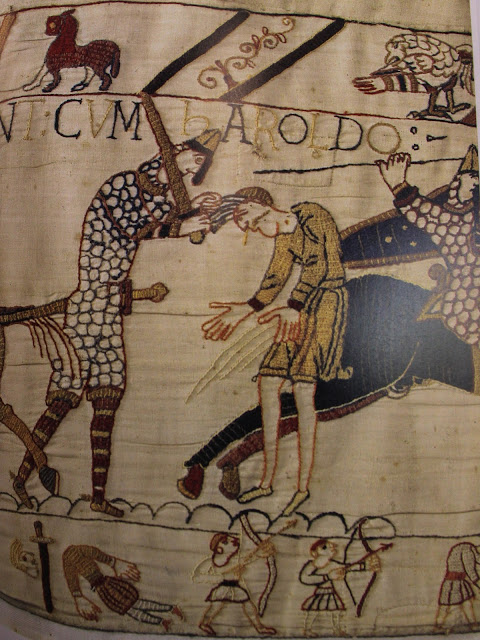So, I have a thing for World War II history. That said, Normandy has always ranked very high on my list of places to see in the world. Renting a car from Paris and driving up there alone was a small but highly enjoyable adventure for me. I loved it. After my stop in Beuvron-en-Auge, I spent the night in Bayeux, which was a major Allied objective during the invasion of Normandy.
Bayeux is a small and charming city with what felt like a bit of a sleepiness about it when I visited. The traffic in the center was not pleasant, and fortunately, I found a public car park on the outskirts and walked in. I wonder: how long will it take before all European city centers are car free? Old cities were clearly not designed for free, efficient movement of such large vehicles, and city centers would be much more pleasant without the noise and congestion that come with jammed roadways. Plus, with such easily walkable areas anyway, it's a shame that we can't just make the more pleasant parts of these beautiful cities car free and use a system of parking garages around them for people's vehicles.
As seemingly everywhere in France, the street life is quite pleasant. There are cafes, brasseries, and little shops all around. The architecture is starkly Norman though, with those half-timbered houses on ancient, rough-hewn stone foundations.

As most bigger towns and cities boast around Europe, Bayeux also has a stunning cathedral that is visible from many vantages around town.
And some arts nouveau touches here and there too; how could I resist?
This picturesque little canal runs through the middle of town. It makes for some nice photos, especially when the light and stillness offers up some wonderful reflection opportunities.
I don't know why, but I can never help snapping shots of complex, layered rooftop profiles like this.
This old dog clearly enjoyed the French lifestyle too. Here he is, sitting in the setting sun, watching people go by on the street below.
You have to wonder what this tree has seen throughout its years...
Normandy has clearly not forgotten those that fought to reclaim their freedom from Nazi occupation. Around Normandy, it is common to see American, British, and Canadian flags flying alongside the French tricolor. There are also many old photos from the war displayed publicly outside, like this one.
And the flags...
Signs like this one are iconic for any WWII buff. They appear regularly in documentary archives from the invasion of Normandy and often also in Hollywood pieces about the war in France. This sign (above) points out the road to Saint Lo, another major allied objective during D-Day.
This museum commemorates the Battle of Normandy during WWII, which was kicked off by the D-Day invasion.
Outside, these tanks showcase some of the terrifying cavalry forces offered up by both sides. Inside, details of each critical operation during the battle are documented, with relics like uniforms, weapons, and equipment on showcase alongside. The tank above is a British Churchill MK VII Crocodile, which, hideously, was a flamethrower tank.
The American M-10 tank
The iconic American M4 Sherman tank
A German Hetzer light tank destroyer
Normandy remembers occupation and the hard fought battle by Allied forces and French Resistance fighters to bring liberty and freedom back to the Norman people and the rest of France. If you're in Bayeux and appreciate modern history, definitely check out this museum and pay respects to the horrors faced by our ancestors just 1-3 generations ago (depending on your age of course).
Just across the street and down the road from the museum is a monument to those who fought against Nazi occupation in the Battle of Normandy and an Allied war cemetery, which is the final resting place of thousands of Allied troops.
Like the cemetery at Omaha Beach, this cemetery is simple in design, with mostly just row upon row upon row of graves marked by clean white tombstones, but it is also so very powerful due to its scope. To think of each one of these graves as a son or daughter, a mother or father, a brother or sister, a cousin, aunt, or uncle, people who lived and were loved by others, it is quite overwhelming. To see so much life and potential ripped violently from our world over such a short period of time is simply an atrocity. War is Hell.
This simple and elegant war memorial sits directly across the street from the cemetery. The structures on either side mark the start and end years of the war (1939 and 1945).
I was lucky to have such beautiful sunset light and spring conditions (blossoms on the trees) while I was there.
The graves stretch far into the distance. Graveyards are cultivated to be such peaceful places, which in one sense is a sign of human hope for the afterlife. It is also an effective, subtle psychological method to make the pain of loss more bearable for the living who visit to remember their dead loved ones. This cemetery surely is a beautiful place for one's body to rest.
The vast majority of the people buried here were Christian, and the name, age, rank, branch of service, and other details are also included on each tombstone.
I couldn't quite tell if this is a tomb for unknown soldiers, but I'm guessing so. As with any battlefield, there are always remains that go unidentified or are unretrievable.
War continues in our world. We have not yet escaped the need for cemeteries like this or mass graves, but we should ever strive to keep such places a haunting and powerful reminder of our past.
Changing pace and going back to the world of the living.
Bayeux's Roman Catholic cathedral is very large and impressive. The cathedral was consecrated in 1077 by none other than William the Conqueror himself. This location is also where William made Harold, King of England, take an oath. Harold broke that oath, which led to William conquering England in 1066. So, Bayeux holds a very, very special place in both French and English history.
This version of the cathedral was built later, after the original was critically damaged in the 12th century. It is constructed in the Gothic style, and the central tower (not visible here) wasn't completed until the 19th century.
As with most cathedrals, it is an enormous and tremendously impressive structure. It never ceases to amaze me what medieval architects, masons, carpenters, blacksmiths, and engineers could accomplish.
Now, onto the main attraction at Bayeux, it's tapestry.
The Bayeux Tapestry is a medieval historical accounting of the Norman conquest of England in 1066. The tapestry is 70 meters long and it is amazing to see it in reality and walk along its full length and appreciate its beautiful detail. The pictures here are from a book, since pictures of the actual tapestry are forbidden.
The tapestry tells the full story of how William the Conquerer made King Harald of England take an oath, which he subsequently broke, leading William to cross the English Channel with his army and defeat Harald's army and kill the King in the Battle of Hastings.
The tapestry supposedly dates from the 11th century; it was likely commissioned as a detailed documentary of the events shortly after they actually took place.
The tapestry is woven with many different colors of thread, and the weaving is intricate. Different weaving patterns and thread weights lead to different textures. It is truly a beautiful piece of medieval art.
It is also graphically detailed, including the horrors of war. Note the beheaded man on the bottom right and the carrion birds ready to swoop in and feast on the fallen.
The death of Harald... apparently he took a nasty head wound.

And the happy ending for the Normans: William, Duke of Normandy, is crowned King of England.












































No comments:
Post a Comment